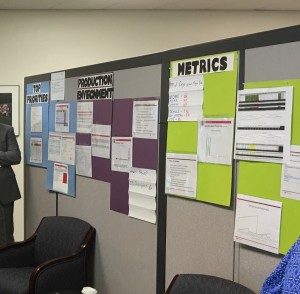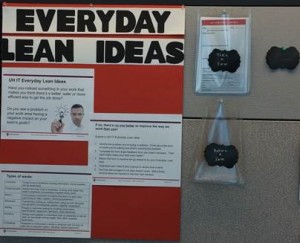It’s been 3 months since the IT leadership team here launched a visual management board and started a thrice-weekly huddle. Since then, we have made numerous adjustments to improve our process.
Initially, the board was in a conference room; we sat around the table for the 15 minute huddles on Monday, Wednesday and Friday mornings. While it was not the ideal setup, it was the way to deal with a distributed leadership team. A few weeks ago, we moved the board out into an open area where everyone walks by and started doing the huddle standing up. We installed a speaker phone next to the board. It’s not a perfect arrangement but it works.
No surprise that it is very different when the group is standing in an open area: more transparency and visibility. We can invite people to observe our huddle and show the board to others who want to learn about it.
Working with the leadership team, we refined our goals to be:
- Reduce cycle time – “get things unstuck”
- Reduce preventable incidents
- Ensure ownership and accountability
- Reduce variation
- Increase coordination and communication between teams
- Ensure we deliver on top priorities
- Focus constantly on customer satisfaction and provide superior service to end users
The sections of the board are the same ones we started with:
- Production environment – To track major incidents and any open tickets that need escalation. We display the number of open tickets by system, critical open tickets, and approved system changes for the week.
- Top priority initiatives – To confirm our highest priorities and review issues that need to be addressed. We display the go live calendar, project successes from the previous week, and the dashboard from the Project Management Office.
- Metrics – To track key department wide metrics. We display metrics including key infrastructure stats, and operating budget vs plan.
- People – To highlight new hires, recognize staff, and raise awareness on recruitment efforts. We list open positions, pictures of new hires, and employee appreciation awards.
- Everyday Lean Ideas (ELI) – To provide a central place for staff to suggest improvements.
We have a standard script for our huddles. We start with the question “are we ready for the business of the day?”.
In the production environment section there is a marker board for “what’s stuck”. We ask the question – “is there anything stuck that needs attention”?
In the metrics section, there is a marker board for “days since major incident”. We track this by major systems including Allscripts for acute and ambulatory EMR, Soarian for revenue cycle, and Oracle for business systems. Similar to metrics such as “days since patient fall” or “days since preventable infection” that nursing units may measure, we track days since a major incident, assuming that we could prevent many of them. When we have to reset one of them to 0 days, it’s a collective letdown. With our Root Cause Analysis (RCA) process for each major incident, we identify the root cause and steps to prevent such an incident from re-occurring. It is part of the learning and improvement cycle.
We have developed a form for Everyday Lean Ideas (ELI) that is available on the visual board or online.  It took a while for staff to start submitting ideas but we’ve received nearly 10 forms at this point. We review new ELI forms each Friday and determine next steps.
It took a while for staff to start submitting ideas but we’ve received nearly 10 forms at this point. We review new ELI forms each Friday and determine next steps.
After the first few weeks of doing the huddle using the visual board, I asked the leadership team what they thought was working well and what improvements were needed. The common themes of what was working was increased communication and awareness across all the teams and helping get things unstuck. Many of the improvements suggested were simple changes we have since made to the board and the huddle process.
For staff who aren’t at the corporate office, we have made portions of it available online for all IT staff – this includes our top priorities, all the information posted in the people section, and the ELI forms.
As we continue the CIO search, the board is a great way for me to show candidates where we’re focused and how we’re managing as a leadership team. And it is an example for other corporate departments to learn from. I hope to see specific team based visual boards throughout the department in the coming months.
Resources:
Visit the Lean Enterprise Institute for resources to transform your company: http://www.lean.org/

Cindy Danko on said:
Glad to hear of the progress! Provides the ability to visually see the roadblocks and focus attention where needed. Our group has had a huddle board in place for quite sometime, wish I could attach a photo to show you. We have a Nascar race theme. The team has really ‘grown’ together as we’ve developed the board, held our huddles and focused effort on the priorities. What really surprised me was how the team bonded during the creation of this activity, there is more respect, issues rise to the top of the leader board and all hands are committed when one of our racers has to go into the ‘Pit Stop’. It’s been an eye opening experience for me, as a Manager, to see the team come together with dedication and commitment through this activity.
Sue Schade on said:
Cindy, what a fantastic team story!! Love the race theme. Sounds like terrific results. Congrats!!
Drex on said:
Beautiful! Sue, I had the text numbers of my geographically separated staff, and used to shoot a few photos of the board and send them out right before huddle started. That way everyone on the phone could “see” the most current updates.
Keep plugging away! Yell if I can help!
Drex
http://www.drex.io
Sue Schade on said:
Drex, another creative way to deal with remote folks. Thanks for the support!